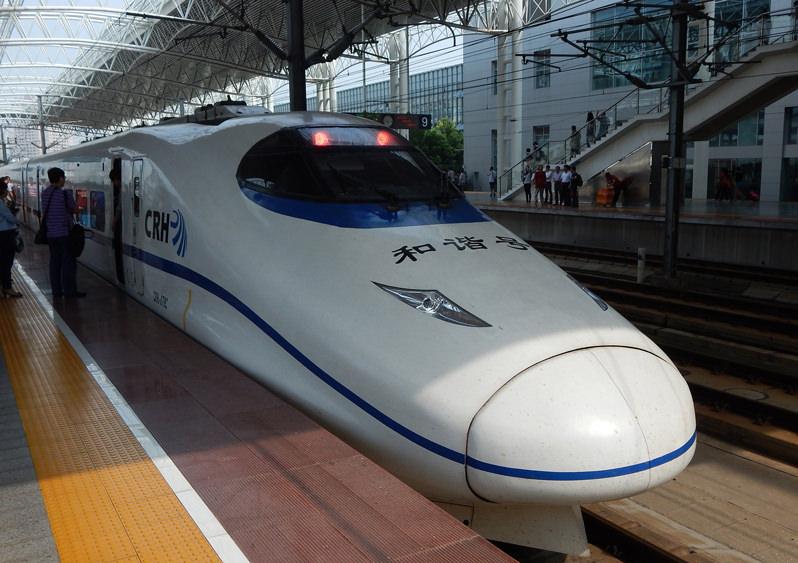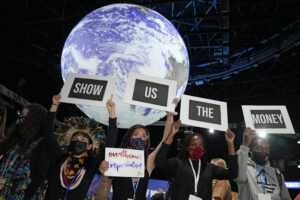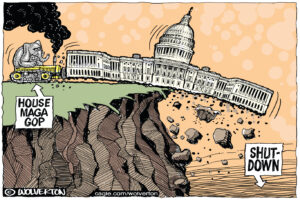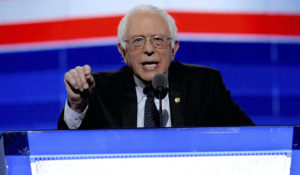If China Can Fund Infrastructure With Its Own Credit, So Can We
While American politicians debate how to finance needed fixes and which fixes to implement, the Chinese have funded massive projects across their country. The Chinese government has funded 12,000 miles of high-speed rail in the last decade. (Richard Barton / CC BY 2.0)
The Chinese government has funded 12,000 miles of high-speed rail in the last decade. (Richard Barton / CC BY 2.0)
By Ellen Brown / Web of Debt
The Chinese government has funded 12,000 miles of high-speed rail in the last decade. (Richard Barton / CC BY 2.0)
May 15 through May 19 was designated “National Infrastructure Week” by the US Chambers of Commerce, the American Society of Civil Engineers (ASCE), and over 150 affiliates. Their message: “It’s time to rebuild.” Ever since ASCE began issuing its “National Infrastructure Report Card” in 1998, the nation has gotten a dismal grade of D or D+. In the meantime, the estimated cost of fixing its infrastructure has gone up from $1.3 trillion to $4.6 trillion.
While American politicians debate endlessly over how to finance the needed fixes and which ones to implement, the Chinese have managed to fund massive infrastructure projects all across their country, including 12,000 miles of high-speed rail built just in the last decade. How have they done it, and why can’t we?
A key difference between China and the US is that the Chinese government owns the majority of its banks. About 40% of the funding for its giant railway project comes from bonds issued by the Ministry of Railway, 10-20% comes from provincial and local governments, and the remaining 40-50% is provided by loans from federally-owned banks and financial institutions. Like private banks, state-owned banks simply create money as credit on their books. (More on this below.) The difference is that they return their profits to the government, making the loans interest-free; and the loans can be rolled over indefinitely. In effect, the Chinese government decides what work it wants done, draws on its own national credit card, pays Chinese workers to do it, and repays the loans with the proceeds.
The US government could do that too, without raising taxes, slashing services, cutting pensions, or privatizing industries. How this could be done quickly and cheaply will be considered here, after a look at the funding proposals currently on the table and at why they are not satisfactory solutions to the nation’s growing infrastructure deficit.
In a May 15, 2017, report on In the Public Interest, the debate taking shape heading into National Infrastructure Week was summarized like this:
The Trump administration, road privatization industry, and a broad mix of congressional leaders are keen on ramping up a large private financing component (under the marketing rubric of ‘public-private partnerships’), but have not yet reached full agreement on what the proportion should be between tax breaks and new public money—and where that money would come from. Over 500 projects are being pitched to the White House. . . .
Democrats have had a full plan on the table since January, advocating for new federal funding and a program of infrastructure renewal spread through a broad range of sectors and regions. And last week, a coalition of right wing, Koch-backed groups led by Freedom Partners . . . released a letter encouraging Congress “to prioritize fiscal responsibility” and focus instead on slashing public transportation, splitting up transportation policy into the individual states, and eliminating labor and environmental protections (i.e., gutting the permitting process). They attacked the idea of a national infrastructure bank and . . . targeted the most important proposal of the Trump administration . . . —to finance new infrastructure by tax reform to enable repatriation of overseas corporate revenues . . . .
In a November 2014 editorial titled “How Two Billionaires Are Destroying High Speed Rail in America,” author Julie Doubleday observed that the US push against public mass transit has been led by a think tank called the Reason Foundation, which is funded by the Koch brothers. Their $44 billion fortune comes largely from Koch Industries, an oil and gas conglomerate with a vested interest in mass transit’s competitors, those single-rider vehicles using the roads that are heavily subsidized by the federal government.
Clearly, not all Republicans are opposed to funding infrastructure, since Donald Trump’s $1 trillion infrastructure plan was a centerpiece of his presidential campaign, and his Republican base voted him into office. But “establishment Republicans” have traditionally opposed infrastructure spending. Why? According to a May 15, 2015 article in Daily Kos titled “Why Do Republicans Really Oppose Infrastructure Spending?”:
Republicans – at the behest of their mega-bank/private equity patrons – really, deeply want to privatize the nation’s infrastructure and turn such public resources into privately owned, profit centers. More than anything else, this privatization fetish explains Republicans’ efforts to gut and discredit public infrastructure . . . .
If the goal is to privatize and monetize public assets, the last thing Republicans are going to do is fund and maintain public confidence in such assets. Rather, when private equity wants to acquire something, the typical playbook is to first make sure that such assets are what is known as “distressed assets” (i.e., cheaper to buy).
A similar argument was advanced by Noam Chomsky in a 2011 lecture titled “The State-Corporate Complex: A Threat to Freedom and Survival”. He said:
[T]here is a standard technique of privatization, namely defund what you want to privatize. Like when Thatcher wanted to [privatize] the railroads, first thing to do is defund them, then they don’t work and people get angry and they want a change. You say okay, privatize them . . . .
Privatization (or “asset relocation” as it is sometimes euphemistically called) means selling public utilities to private equity investors, who them rent them back to the public, squeezing their profits from high user fees and tolls. Private equity investment now generates an average return of about 11.8 percent annually on a ten-year basis. That puts the cost to the public of financing $1 trillion in infrastructure projects over 10 years at around $1.18 trillion, more than doubling the cost. Moving assets off the government’s balance sheet by privatizing them looks attractive to politicians concerned with this year’s bottom line, but it’s a bad deal for the public. Decades from now, people will still be paying higher tolls for the sake of Wall Street profits on an asset that could have belonged to them all along.
One example is the Dulles Greenway, a toll road outside Washington, D.C., nicknamed the “Champagne Highway” due to its extraordinarily high rates and severe underutilization in a region crippled by chronic traffic problems. Local (mostly Republican) officials have tried in vain for years to either force the private owners to lower the toll rates or have the state take the road into public ownership. In 2014, the private operators of the Indiana Toll Road, one of the best-known public-private partnerships (PPPs), filed for bankruptcy after demand dropped, due at least in part to rising toll rates. Other high-profile PPP bankruptcies have occurred in San Diego, CA; Richmond, VA; and Texas.
Countering the dogma that “private companies can always do it better and cheaper,” studies have found that on average, private contractors charge more than twice as much as the government would have paid federal workers for the same job. A 2011 report by the Brookings Institution found that “in practice [PPPs] have been dogged by contract design problems, waste, and unrealistic expectations.” In their 2015 report “Why Public-Private Partnerships Don’t Work,” Public Services International stated that “[E]xperience over the last 15 years shows that PPPs are an expensive and inefficient way of financing infrastructure and divert government spending away from other public services. They conceal public borrowing, while providing long-term state guarantees for profits to private companies.” They also divert public money away from the neediest infrastructure projects, which may not deliver sizable returns, in favor of those big-ticket items that will deliver hefty profits to investors.
The Trump team has also reportedly discussed the possibility of an infrastructure bank, but that proposal faces similar hurdles. The details of the proposal are as yet unknown, but past conceptions of an infrastructure bank envision a quasi-bank (not a physical, deposit-taking institution) seeded by the federal government, possibly from taxes on the repatriation of offshore corporate profits. The bank would issue bonds, tax credits, and loan guarantees to state and local governments to leverage private sector investment. As with the private equity proposal, an infrastructure bank would rely on public-private partnerships and investors who would be disinclined to invest in projects that did not generate hefty returns. And those returns would again be paid by the public in the form of tolls, fees, higher rates, and payments from state and local governments.
There is another way to set up a publicly-owned bank. Today’s infrastructure banks are basically revolving funds. A dollar invested is a dollar lent, which must return to the bank (with interest) before it can be lent again. A chartered depository bank, on the other hand, can turn a one-dollar investment into ten dollars in loans. It can do this because depository banks actually create deposits when they make loans. This was acknowledged by economists both at the Bank of England (in a March 2014 paper entitled “Money Creation in the Modern Economy”) and at the Bundesbank (the German central bank) in an April 2017 report.
Contrary to conventional wisdom, money is not fixed and scarce. It is “elastic”: it is created when loans are made and extinguished when they are paid off. The Bank of England report said that private banks create nearly 97 percent of the money supply today. Borrowing from banks (rather than the bond market) expands the circulating money supply. This is something the Federal Reserve tried but failed to do with its quantitative easing (QE) policies: stimulate the economy by expanding the bank lending that expands the money supply.
The stellar (and only) model of a publicly-owned depository bank in the United States is the Bank of North Dakota (BND). It holds all of its home state’s revenues as deposits by law, acting as a sort of “mini-Fed” for North Dakota. According to reports, the BND is more profitable even than Goldman Sachs, has a better credit rating than J.P. Morgan Chase, and has seen solid profit growth for almost 15 years. The BND continued to report record profits after two years of oil bust in the state, suggesting that it is highly profitable on its own merits because of its business model. The BND does not pay bonuses, fees, or commissions; has no high paid executives; does not speculate on risky derivatives; does not have multiple branches; does not need to advertise; and does not have private shareholders seeking short-term profits. The profits return to the bank, which distributes them as dividends to the state.
The federal government could set up a bank on a similar model. It has massive revenues, which it could leverage into credit for its own purposes. Since financing is typically about 50 percent of the cost of infrastructure, the government could cut infrastructure costs in half by borrowing from its own bank. Public-private partnerships are a good deal for investors but a bad deal for the public. The federal government can generate its own credit without private financial middlemen. That is how China does it, and we can too.
Your support matters…Independent journalism is under threat and overshadowed by heavily funded mainstream media.
You can help level the playing field. Become a member.
Your tax-deductible contribution keeps us digging beneath the headlines to give you thought-provoking, investigative reporting and analysis that unearths what's really happening- without compromise.
Give today to support our courageous, independent journalists.






You need to be a supporter to comment.
There are currently no responses to this article.
Be the first to respond.